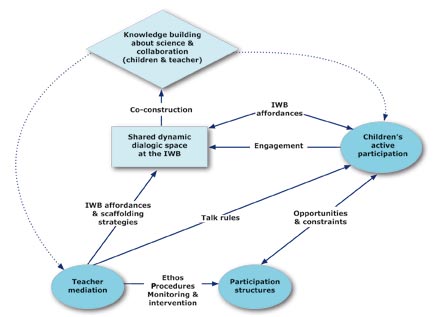 Findings Model
Findings Model
Our model of collaborative learning at the IWB shows:
- the centrality of a shared dialogic space;
- that knowledge building derives from interactions and co-construction within the dialogic space
- that certain linked elements contribute to the maintenance and success of a dialogic space at the IWB: teacher mediation, children's active participation, classroom participation structures.
Teacher mediation is both direct and indirect. It involves the embedding of cues and use of enabling IWB features, the monitoring and support of children's activity and the establishment of effective collaboration and dialogue as part of classroom learning.
Children's active participation is evidenced by the use both of talk rules and of the affordances of the IWB (e.g. assistive memory, provisionality and stability, external representation of thinking through object manipulation). The children's engagement is cognitive, affective, motivational, physical and social.
Classroom participation structures comprise the established classroom ethos, procedures and working relationships. These provide opportunities and constraints for children's activity at the IWB. They are in turn influenced by children's and teachers' responses to the use of the IWB for collaborative learning.
An evolving model
Model of collaborative learning - version 2
As a result of writing and thinking about the project, and using some very helpful feedback from referees for submitted papers, we have been reconsidering the model. We have made two particular alterations on the basis of these considerations:
1). We felt that teacher monitoring and intervention were more properly allied with classroom participation structures.
2). We have expressed the nature of teacher's 'vicarious' mediation of learning using the IWB more fully, connecting this to the creation of a shared, dynamic dialogic space.
In addition, we feel that the bi-directional nature of the IWB affordances link between children's active participation and the dialogic space may need some explanation. Here, we draw attention to the fact that the IWB affordances integrated by the teacher into the task structure can both provide a stimulus for children’s active participation in tasks and facilitate the kinds of interactions that build a shared and dynamic dialogic space. But this cycle does not rely exclusively on the ways in which the teacher has mediated the activity at the IWB; the cycle of interaction can be developed where the pupils themselves perceive additional enabling features of the technology as affordances for learning (as where, in one class, the pupils began to use the facility to cut and paste objects as a means of expressing their understanding of the reflective and non-reflective objects).

